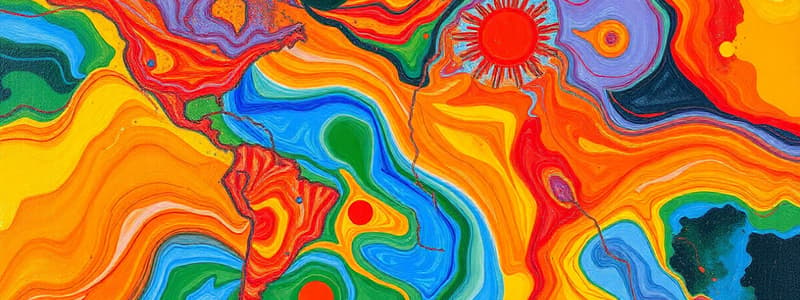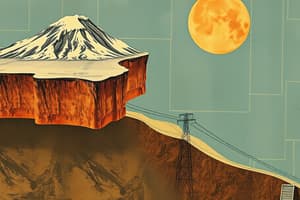Podcast
Questions and Answers
The Earth's surface is reshaped by the interactions at plate boundaries, which can result in the formation of mountains, earthquakes, and ocean ______.
The Earth's surface is reshaped by the interactions at plate boundaries, which can result in the formation of mountains, earthquakes, and ocean ______.
trenches
At divergent boundaries, plates ______ creating new lithosphere as magma rises from the mantle.
At divergent boundaries, plates ______ creating new lithosphere as magma rises from the mantle.
move apart
The collision of two continental plates at a convergent boundary, where neither plate subducts, leads to the formation of massive mountain ranges like the ______.
The collision of two continental plates at a convergent boundary, where neither plate subducts, leads to the formation of massive mountain ranges like the ______.
Himalayas
Frequent earthquakes are observed along fault lines at transform boundaries due to the ______ of plates sliding past each other horizontally.
Frequent earthquakes are observed along fault lines at transform boundaries due to the ______ of plates sliding past each other horizontally.
The San Andreas Fault is an example of a ______ boundary, where plates slide past each other horizontally.
The San Andreas Fault is an example of a ______ boundary, where plates slide past each other horizontally.
Unlike at convergent or divergent boundaries, crust is neither created nor ______ at transform boundaries.
Unlike at convergent or divergent boundaries, crust is neither created nor ______ at transform boundaries.
At convergent boundaries, the ______ plate usually subducts beneath the less dense plate, leading to the formation of ocean trenches.
At convergent boundaries, the ______ plate usually subducts beneath the less dense plate, leading to the formation of ocean trenches.
Mid-ocean ridges and rift valleys are often formed at ______ boundaries, where plates move apart.
Mid-ocean ridges and rift valleys are often formed at ______ boundaries, where plates move apart.
Plate boundary interactions significantly impact the planet's landscape, climate, and the ______ of life.
Plate boundary interactions significantly impact the planet's landscape, climate, and the ______ of life.
Those plate boundaries that are clearly defined, such as mid-ocean ridges and ocean trenches, have distinct ______ features.
Those plate boundaries that are clearly defined, such as mid-ocean ridges and ocean trenches, have distinct ______ features.
Flashcards
Divergent Boundaries
Divergent Boundaries
Plates move apart, creating new lithosphere. Magma rises, forming mid-ocean ridges and rift valleys.
Convergent Boundaries
Convergent Boundaries
Plates collide; the denser plate subducts, forming trenches and volcanic mountain ranges.
Transform Boundaries
Transform Boundaries
Plates slide past each other horizontally, creating friction and earthquakes.
Mid-ocean ridges
Mid-ocean ridges
Signup and view all the flashcards
Subduction
Subduction
Signup and view all the flashcards
Ocean trenches
Ocean trenches
Signup and view all the flashcards
Tectonic Plates
Tectonic Plates
Signup and view all the flashcards
Lithosphere
Lithosphere
Signup and view all the flashcards
Plate Tectonics
Plate Tectonics
Signup and view all the flashcards
Mountain Ranges (at Convergent Boundaries)
Mountain Ranges (at Convergent Boundaries)
Signup and view all the flashcards
Study Notes
- Tectonic plates are constantly moving and interacting at their boundaries. These interactions shape the Earth's surface.
Types of Plate Boundaries
- There are three main types of plate boundaries: divergent, convergent, and transform.
Divergent Boundaries
- Plates move apart at divergent boundaries, creating new lithosphere.
- Magma rises from the mantle to fill the gap, forming mid-ocean ridges and rift valleys.
- Earthquakes are common, but generally smaller than at other boundaries.
Convergent Boundaries
- Plates collide at convergent boundaries.
- The denser plate usually subducts beneath the less dense plate, forming deep ocean trenches and volcanic mountain ranges.
- Powerful earthquakes are common at these boundaries.
- If two continental plates collide, neither subducts, resulting in the formation of massive mountain ranges like the Himalayas.
Transform Boundaries
- Plates slide past each other horizontally at transform boundaries.
- This creates significant friction, leading to frequent earthquakes along fault lines like the San Andreas Fault.
- Crust is neither created nor destroyed at these boundaries.
Well-Defined vs. Poorly Defined Boundaries
- Some plate boundaries are clearly defined by topographic features like mid-ocean ridges and ocean trenches.
- Others are less distinct, making their mapping more challenging.
Global Impact
- Plate boundary interactions are responsible for many of Earth's most dramatic geological features and events.
- Plate boundary interactions significantly impact the planet's landscape, climate, and the distribution of life.
Studying That Suits You
Use AI to generate personalized quizzes and flashcards to suit your learning preferences.




